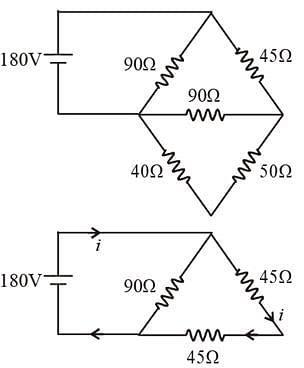
In the circuit shown in the figure, find the current in \[45\Omega \].

A. \[4\;{\rm{A}}\]
B. \[2.5\;{\rm{A}}\]
C. \[2\;{\rm{A}}\]
D. None of these
Answer
219k+ views
Hint: In this case, we have to calculate the voltage drops across the resistance elements using Ohm's Law. The values of these currents are then entered into the Current law expression to obtain a suitable value for current. We'll keep simplifying the circuit by employing equivalent resistances instead of a resistor combination. On the last simplest circuit, we will discover the current, divide it into branches, and then find the current via each branch.
Formula used:
The formula for finding the current in \[45\Omega \] are:
\[v = i \times R\]
Equivalent resistance in series is given by
\[R = {R_1} + {R_2} + ....... + {R_9}\]
Equivalent resistance in parallel is given by
\[\dfrac{1}{{{R_p}}} = \dfrac{1}{{{R_1}}} + \dfrac{1}{{{R_2}}} + ....... + \dfrac{1}{{{R_n}}}\]
Complete step by step solution:
We have been given the circuit diagram in the question. Now, let us split the circuit into branches for easy understanding, we obtain

In the given circuit, we have been understood that voltage is
\[180\;{\rm{V}}\]
The sign “I” is commonly used to represent current. Ohm's law states that the current flowing through a conductor is proportional to the voltage V and resistance R.
That is, \[{\rm{V = IR}}\]
Ohm's law can also be stated as,
\[{\rm{i = }}\dfrac{{\rm{V}}}{{\rm{R}}}\]
Now, we have to substitute the values given in the circuit in the above formula, we get
\[i = \dfrac{{180}}{{90}}\]
Now, let’s simplify the above expression, we get
\[{\rm{i = 2A}}\]
Therefore, the current in \[45\Omega \] is \[{\rm{2}}\] Ampere.
Hence, the option C is correct.
Note: Keep in mind that current does not always divide evenly between the two branches of the circuit. It is determined by the amount of resistance between them. The current was divided equally in this case because the resistance on the two branches of the circuit was equal.
Formula used:
The formula for finding the current in \[45\Omega \] are:
\[v = i \times R\]
Equivalent resistance in series is given by
\[R = {R_1} + {R_2} + ....... + {R_9}\]
Equivalent resistance in parallel is given by
\[\dfrac{1}{{{R_p}}} = \dfrac{1}{{{R_1}}} + \dfrac{1}{{{R_2}}} + ....... + \dfrac{1}{{{R_n}}}\]
Complete step by step solution:
We have been given the circuit diagram in the question. Now, let us split the circuit into branches for easy understanding, we obtain

In the given circuit, we have been understood that voltage is
\[180\;{\rm{V}}\]
The sign “I” is commonly used to represent current. Ohm's law states that the current flowing through a conductor is proportional to the voltage V and resistance R.
That is, \[{\rm{V = IR}}\]
Ohm's law can also be stated as,
\[{\rm{i = }}\dfrac{{\rm{V}}}{{\rm{R}}}\]
Now, we have to substitute the values given in the circuit in the above formula, we get
\[i = \dfrac{{180}}{{90}}\]
Now, let’s simplify the above expression, we get
\[{\rm{i = 2A}}\]
Therefore, the current in \[45\Omega \] is \[{\rm{2}}\] Ampere.
Hence, the option C is correct.
Note: Keep in mind that current does not always divide evenly between the two branches of the circuit. It is determined by the amount of resistance between them. The current was divided equally in this case because the resistance on the two branches of the circuit was equal.
Recently Updated Pages
A square frame of side 10 cm and a long straight wire class 12 physics JEE_Main

The work done in slowly moving an electron of charge class 12 physics JEE_Main

Two identical charged spheres suspended from a common class 12 physics JEE_Main

According to Bohrs theory the timeaveraged magnetic class 12 physics JEE_Main

ill in the blanks Pure tungsten has A Low resistivity class 12 physics JEE_Main

The value of the resistor RS needed in the DC voltage class 12 physics JEE_Main

Trending doubts
JEE Main 2026: Application Form Open, Exam Dates, Syllabus, Eligibility & Question Papers

Derivation of Equation of Trajectory Explained for Students

Hybridisation in Chemistry – Concept, Types & Applications

Understanding the Angle of Deviation in a Prism

Understanding Collisions: Types and Examples for Students

Understanding Atomic Structure for Beginners

Other Pages
JEE Advanced Marks vs Ranks 2025: Understanding Category-wise Qualifying Marks and Previous Year Cut-offs

How to Convert a Galvanometer into an Ammeter or Voltmeter

Understanding Centrifugal Force in Physics

JEE Main Marking Scheme 2026- Paper-Wise Marks Distribution and Negative Marking Details

Degree of Dissociation: Meaning, Formula, Calculation & Uses

Understanding Electromagnetic Waves and Their Importance




